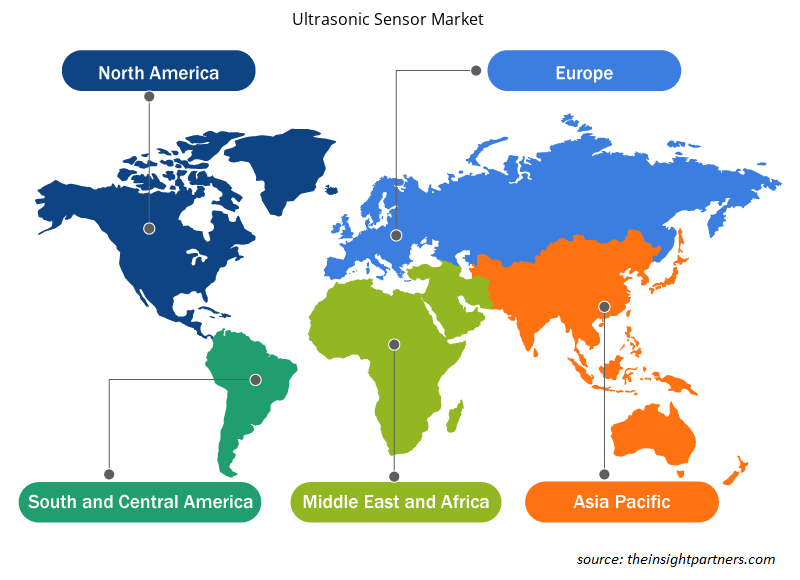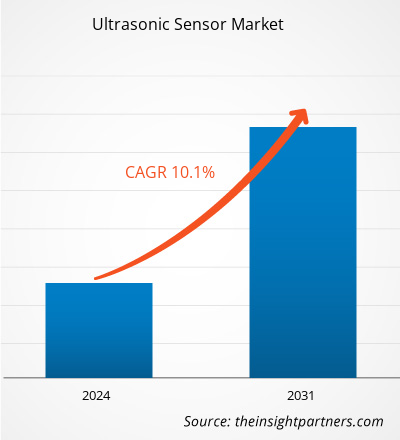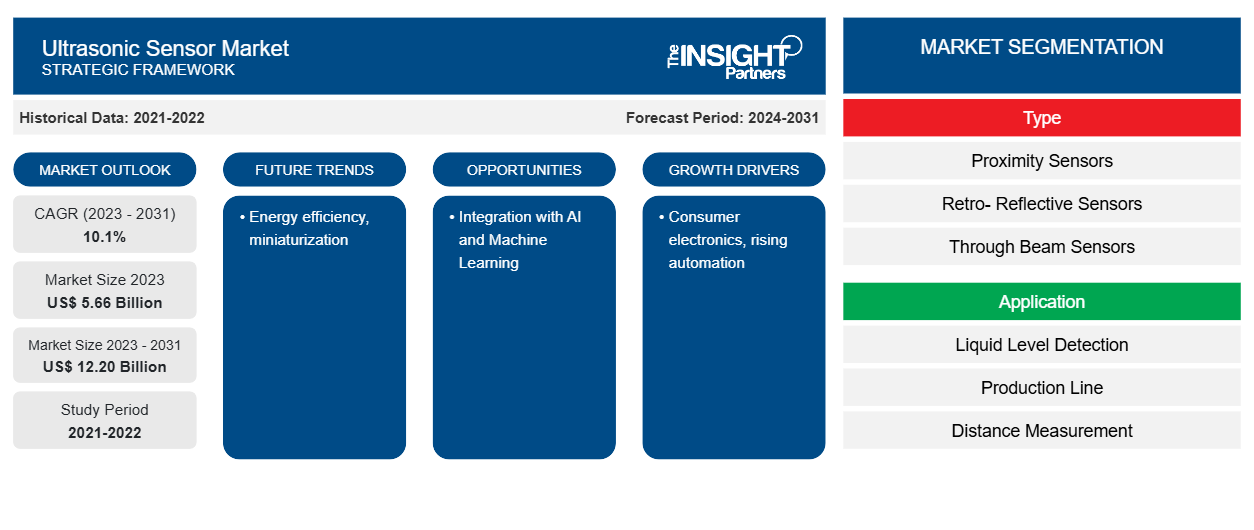Si prevede che la dimensione del mercato dei sensori a ultrasuoni raggiungerà i 12,20 miliardi di dollari entro il 2031, rispetto ai 5,66 miliardi di dollari del 2023. Si prevede che il mercato registrerà un CAGR del 10,1% nel 2023-2031. È probabile che l'efficienza energetica e la miniaturizzazione rimangano le tendenze chiave del mercato dei sensori a ultrasuoni.
Analisi del mercato dei sensori ad ultrasuoni
I sensori a ultrasuoni sono utilizzati per una vasta gamma di applicazioni in tutto il mondo, sia all'interno che all'esterno, in ambienti difficili. I sensori a ultrasuoni possono essere utilizzati nel processo di produzione per automatizzare il controllo di processo sul pavimento della fabbrica e sono anche uno strumento essenziale per le aziende per massimizzare la produttività attraverso una misurazione e un controllo precisi. I sensori a ultrasuoni possono stimare la distanza da una varietà di oggetti, indipendentemente dalla forma, dal colore o dalla consistenza della superficie. Possono anche misurare un oggetto mentre si avvicina o si allontana. Per applicazioni simili, i sensori a ultrasuoni vengono utilizzati in importanti settori come l'automotive, la produzione e l'assistenza sanitaria , tra gli altri. Ciò sta guidando la crescita del mercato.
Panoramica del mercato dei sensori a ultrasuoni
L'attuale panorama industriale con l'integrazione massiccia dell'IoT, l'automazione industriale ha creato uno spazio impressionante per l'espansione delle applicazioni per l'uso di sensori a ultrasuoni. La crescente complessità dell'automazione nell'ambiente industriale sta guidando la domanda nel mercato. Gli attori del mercato sono attivamente coinvolti nell'introduzione di prodotti nuovi e innovativi. Ad esempio, nell'agosto 2022, Toposens ha introdotto il primo sensore anticollisione a ultrasuoni 3D al mondo per l'uso in applicazioni industriali per migliorare la produttività e la sicurezza attraverso l'uso di apparecchiature automatizzate.
Personalizza questo report in base alle tue esigenze
Riceverai la personalizzazione gratuita di qualsiasi report, comprese parti di questo report, o analisi a livello nazionale, pacchetto dati Excel, oltre a usufruire di grandi offerte e sconti per start-up e università
-
Scopri le principali tendenze di mercato in questo rapporto.Questo campione GRATUITO includerà analisi di dati che spaziano dalle tendenze di mercato alle stime e alle previsioni.
Driver e opportunità del mercato dei sensori a ultrasuoni
L'automazione industriale in crescita favorisce il mercato
I sensori a ultrasuoni sono sensori versatili nel campo dell'automazione industriale, con diverse varietà disponibili, ciascuna su misura per un'applicazione unica. I sensori a ultrasuoni nelle linee di produzione automatizzate assicurano che i bracci robotici e i macchinari funzionino correttamente. Assistono in attività come l'allineamento dei componenti e la garanzia che le parti siano posizionate correttamente per l'assemblaggio o la lavorazione.
Integrazione con AI e Machine Learning: un’opportunità nei sensori a ultrasuoni
I sensori a ultrasuoni vengono sempre più integrati con algoritmi di intelligenza artificiale (AI) e apprendimento automatico. Questa integrazione consentirà un'elaborazione dei dati più intelligente, consentendo ai sensori di rispondere a condizioni mutevoli e di fare previsioni più accurate. Questo miglioramento è molto promettente per applicazioni complesse come la manutenzione predittiva e il controllo qualità.
Analisi della segmentazione del rapporto di mercato dei sensori ad ultrasuoni
I segmenti chiave che hanno contribuito alla derivazione dell'analisi di mercato dei sensori a ultrasuoni sono tipologia, applicazione e settore verticale.
- In base al tipo, il mercato dei sensori a ultrasuoni è suddiviso in sensori di prossimità, sensori retroriflettenti, sensori a sbarramento e altri. Il segmento dei sensori a sbarramento ha detenuto la quota maggiore del mercato nel 2023.
- In base all'applicazione, il mercato dei sensori a ultrasuoni è suddiviso in rilevamento del livello del liquido, linea di produzione, misurazione della distanza e altri.
- In base al settore verticale, il mercato è segmentato in automotive, food & beverage, medical, oil & gas, industrial e altri.
Analisi della quota di mercato dei sensori a ultrasuoni per area geografica
L'ambito geografico del rapporto sul mercato dei sensori a ultrasuoni è suddiviso principalmente in cinque regioni: Nord America, Asia Pacifico, Europa, Medio Oriente e Africa e Sud America/Sud e Centro America.
L'Europa ha dominato laMercato dei sensori a ultrasuoni. L'automazione crescente e l'Industria 4.0 nei paesi europei stanno guidando la domanda di sensori a ultrasuoni nella regione. Il mercato dei sensori a ultrasuoni sta subendo uno sviluppo sostanziale in Nord America, che può essere attribuito allo sviluppo dei settori automobilistico e dei trasporti.
Approfondimenti regionali sul mercato dei sensori a ultrasuoni
Le tendenze regionali e i fattori che influenzano il mercato dei sensori a ultrasuoni durante il periodo di previsione sono stati ampiamente spiegati dagli analisti di Insight Partners. Questa sezione discute anche i segmenti e la geografia del mercato dei sensori a ultrasuoni in Nord America, Europa, Asia Pacifico, Medio Oriente e Africa e America meridionale e centrale.

- Ottieni i dati specifici regionali per il mercato dei sensori a ultrasuoni
Ambito del rapporto sul mercato dei sensori ad ultrasuoni
| Attributo del report | Dettagli |
|---|---|
| Dimensioni del mercato nel 2023 | 5,66 miliardi di dollari USA |
| Dimensioni del mercato entro il 2031 | 12,20 miliardi di dollari USA |
| CAGR globale (2023-2031) | 10,1% |
| Dati storici | 2021-2022 |
| Periodo di previsione | 2024-2031 |
| Segmenti coperti |
Per tipo
|
| Regioni e Paesi coperti |
America del Nord
|
| Leader di mercato e profili aziendali chiave |
|
Densità dei player del mercato dei sensori a ultrasuoni: comprendere il suo impatto sulle dinamiche aziendali
Il mercato dei sensori a ultrasuoni sta crescendo rapidamente, spinto dalla crescente domanda degli utenti finali dovuta a fattori quali l'evoluzione delle preferenze dei consumatori, i progressi tecnologici e una maggiore consapevolezza dei vantaggi del prodotto. Con l'aumento della domanda, le aziende stanno ampliando le loro offerte, innovando per soddisfare le esigenze dei consumatori e capitalizzando sulle tendenze emergenti, il che alimenta ulteriormente la crescita del mercato.
La densità degli operatori di mercato si riferisce alla distribuzione di aziende o società che operano in un particolare mercato o settore. Indica quanti concorrenti (operatori di mercato) sono presenti in un dato spazio di mercato in relazione alle sue dimensioni o al valore di mercato totale.
Le principali aziende che operano nel mercato dei sensori a ultrasuoni sono:
- Toposens
- Baumer
- Automazione Rockwell
- Siemens
- Honeywell International Inc
- Azienda
Disclaimer : le aziende elencate sopra non sono classificate secondo un ordine particolare.

- Ottieni una panoramica dei principali attori del mercato dei sensori a ultrasuoni
Notizie e sviluppi recenti sul mercato dei sensori ad ultrasuoni
Il mercato dei sensori a ultrasuoni viene valutato raccogliendo dati qualitativi e quantitativi post-ricerca primaria e secondaria, che include importanti pubblicazioni aziendali, dati di associazioni e database. Di seguito è riportato un elenco di sviluppi nel mercato dei sensori a ultrasuoni e strategie:
- Il produttore leader di elettronica Murata ha annunciato l'introduzione di un nuovo dispositivo sensore a ultrasuoni destinato all'impiego in applicazioni automobilistiche. Con elevata sensibilità e rapida reattività, il MA48CF15-7N è alloggiato in un contenitore ermeticamente sigillato per proteggere dall'ingresso di liquidi. (Fonte: Murata Manufacturing Co., Ltd., Comunicato stampa, 2023)
Copertura e risultati del rapporto sul mercato dei sensori a ultrasuoni
Il rapporto "Dimensioni e previsioni del mercato dei sensori a ultrasuoni (2023-2031)" fornisce un'analisi dettagliata del mercato che copre le seguenti aree:
- Dimensioni e previsioni del mercato a livello globale, regionale e nazionale per tutti i segmenti di mercato chiave coperti dall'ambito
- Dinamiche di mercato come fattori trainanti, vincoli e opportunità chiave
- Principali tendenze future
- Analisi dettagliata delle cinque forze PEST/Porter e SWOT
- Analisi di mercato globale e regionale che copre le principali tendenze di mercato, i principali attori, le normative e gli sviluppi recenti del mercato
- Analisi del panorama industriale e della concorrenza che copre la concentrazione del mercato, l'analisi della mappa di calore, i principali attori e gli sviluppi recenti
- Profili aziendali dettagliati
- Analisi storica (2 anni), anno base, previsione (7 anni) con CAGR
- Analisi PEST e SWOT
- Valore/volume delle dimensioni del mercato - Globale, Regionale, Nazionale
- Industria e panorama competitivo
- Set di dati Excel
Report recenti
Rapporti correlati
Testimonianze
Motivo dell'acquisto
- Processo decisionale informato
- Comprensione delle dinamiche di mercato
- Analisi competitiva
- Analisi dei clienti
- Previsioni di mercato
- Mitigazione del rischio
- Pianificazione strategica
- Giustificazione degli investimenti
- Identificazione dei mercati emergenti
- Miglioramento delle strategie di marketing
- Aumento dell'efficienza operativa
- Allineamento alle tendenze normative























 Ottieni un campione gratuito per - Mercato dei sensori ad ultrasuoni
Ottieni un campione gratuito per - Mercato dei sensori ad ultrasuoni